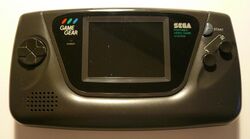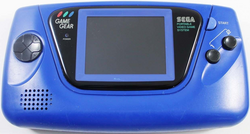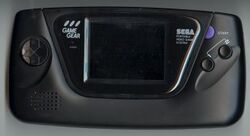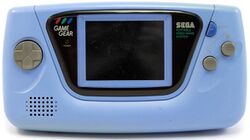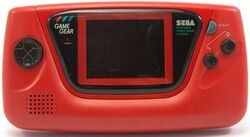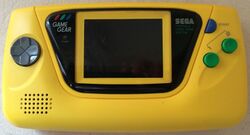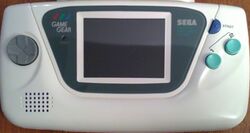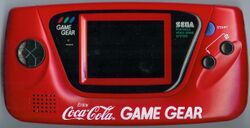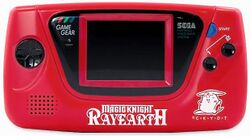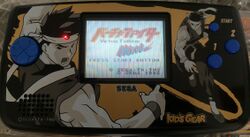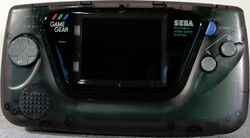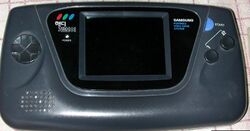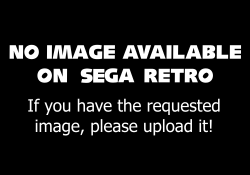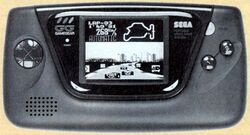Difference between revisions of "Sega Game Gear"
From Sega Retro
| (280 intermediate revisions by 29 users not shown) | |||
| Line 1: | Line 1: | ||
| − | + | :''For the American automobile manufacturer, see [[Mercury (company)]].'' | |
| + | {{ConsoleBob | ||
| + | | logo=Gamegear us logo.svg | ||
| + | | consoleimage=Gamegear.jpg | ||
| + | | maker=[[Sega]] | ||
| + | | variants= | ||
| + | | add-ons= | ||
| + | | processor= | ||
| + | | releases={{releasesGG | ||
| + | | gg_date_jp=1990-10-06{{ref|https://web.archive.org/web/20201108225550/https://sega.jp/history/hard/gamegear/}} | ||
| + | | gg_rrp_jp=19,800 | ||
| + | | gg_code_jp=HGG-3200 | ||
| − | + | | gg_date_us_1=1991-04-15{{magref|gamepro|22|8}} | |
| + | | gg_rrp_us_1=149.95{{magref|gamepro|22|16}} | ||
| + | | gg_type_us_1=NY/LA | ||
| + | | gg_date_us_2=1991-04-26 | ||
| + | | gg_rrp_us_2=149.95{{magref|gamepro|22|16}} | ||
| + | | gg_type_us_2=Nationwide | ||
| − | + | | gg_date_uk=1991-06-29{{fileref|DailyMirror_UK_1991-06-29_08.png}} | |
| + | | gg_rrp_uk=99.99{{fileref|DailyMirror_UK_1991-06-29_08.png}}{{magref|mm|9|11}}{{magref|raze|11|17}} | ||
| + | | gg_date_fr=1991-06 | ||
| + | | gg_date_de=1991 | ||
| + | | gg_date_es=1991 | ||
| + | | gg_date_it=1991 | ||
| + | | gg_date_pt=199x | ||
| + | | gg_date_cz=1992-10 | ||
| + | | gg_date_br=1991-07{{magref|ag|3|14}} | ||
| + | | gg_rrp_br=160,000 | ||
| + | | gg_date_au=1992 | ||
| + | | gg_date_kr=1991-01 | ||
| + | | gg_code_kr=SPC-150 | ||
| + | | gg_rrp_kr=198,000 | ||
| + | | gg_date_mx=199x | ||
| + | | gg_date_se=199x | ||
| − | + | | gg_date_sa=199x{{magref|alaabalc|1|12}} | |
| + | | gg_rrp_sa=500{{magref|alaabalc|1|12}} | ||
| + | }} | ||
| + | }} | ||
| + | <section begin=intro />The '''Game Gear''' (ゲームギア) is a handheld video game console developed by [[Sega]] and released in late 1990 as a response to [[Nintendo]]'s [[Game Boy]] handheld . It is a full colour console and was Sega's first attempt to compete in the handheld games market (the second being the [[Sega Nomad]] — a handheld [[Mega Drive]]). In South Korea it is known as the '''Handy Gam*Boy''' (핸디겜보이) and '''Handy Aladdin Boy''' (핸디알라딘보이).<section end=intro /> | ||
| − | + | After development of the [[Sega Saturn]] began, the Game Gear was retroactively given the codename '''Mercury'''{{ref|1=https://www.youtube.com/watch?v=wqdN_L4YaDE}}. | |
| − | + | ==Hardware== | |
| + | The Game Gear is a "portable" device which was designed to address problems with Nintendo's Game Boy. It is held lengthwise at the sides (preventing the cramping of hands which plagued Nintendo's system) and has a backlit, colour LCD screen, allowing for clearer and more vibrant visuals than its main rival. | ||
| − | + | Similarly to the [[Mega Drive]], which at the time was Sega's main focus in the home console market, the Game Gear is derived from the earlier [[Sega Master System]]. Unlike the Mega Drive, however, the Game Gear is largely identical to the Master System, the major difference being a VDP capable of displaying palettes consisting of a wider variety of colors, and the playback of stereo sound. Game Gear games traditionally run at a smaller resolution too, although with a screen built similarly to televisions of the era, the Game Gear is fully capable of playing games in higher resolutions. | |
| − | + | Like the Master System, the Game Gear features a D-Pad and two buttons, {{1}} and {{2}}, but also adds a third, {{Start}}. This is one button short of a Game Boy. | |
| − | + | Unfortunately, due to technical limitations of the era, the Game Gear demands six AA batteries to be played on the go, of which the fluorescent backlight on the LCD screen will eat through in three to five hours (though a [[Sega Game Gear Battery Pack|battery pack]] provides longer playtime). Furthermore, the system gives off more heat than the Game Boy, often leading to "sweaty palms" after prolonged use. The system was also considered not to be very "portable" - its bulky size means it does not fit in many pockets, and the power-draining backlight of the LCD screen (which cannot be turned off) meant Game Gears were unusable after a short period of time. An [[AC adaptor]] can be plugged into the system so that it runs off the mains, but this was not considered practical for consumers of the day. | |
| − | |||
| − | + | Game Gears were also manufactured at a time where capacitor problems were rampant across the electronics industry. As a result, screen and audio failures are common, and fixes are not always simple. | |
| − | |||
| − | |||
| − | |||
| − | |||
| − | |||
| − | |||
| − | |||
| − | |||
| − | |||
| − | |||
| − | === | + | ===Models=== |
| − | + | {{mainArticle|Game Gear consoles}} | |
| − | + | <gallery widths="250px" heights="200px"> | |
| − | + | Gamegear.jpg|Worldwide model | |
| − | + | GameGear Blue US.jpg|North American model (Sports Edition) | |
| − | + | GameGear Majesco.jpg|North American model (Majesco) | |
| − | + | GG Blue JP 1.jpg|Japanese model (light blue) | |
| − | + | GG Red JP 1.jpg|Japanese model (red) | |
| − | + | GG Yellow JP 1.jpg|Japanese model (yellow) | |
| − | + | GG White JP Front.jpg|Japanese model (white) | |
| − | + | gg_cc.jpg|Japanese model (''[[Coca Cola Kid]]'' edition (Model #3210CR)) | |
| − | + | gg_ray.jpg|Japanese model (''[[Magic Knight Rayearth]]'' edition (Model #HGG-3210 RAY)) | |
| − | + | GG VF JP 1.jpg|''Kid's Gear''{{ref|https://web.archive.org/web/19970215222051/http://www.sega.co.jp/sega/athome/toys/k.html}}{{ref|https://web.archive.org/web/19970216135947/http://www.sega.co.jp/sega_e/athome/toys/k.html}} (キッズギア) Japanese model (''[[Virtua Fighter Mini]]'' edition) | |
| − | + | GG Smoke.jpg|Japanese model (Smoke) | |
| − | + | HandyGamBoy.jpg|Korean model (Handy Gam*Boy) | |
| − | + | Notavailable.svg|Korean model (Handy Aladdin Boy) | |
| − | + | GGProto.jpg|Prototype model | |
| − | |||
| − | |||
| − | |||
</gallery> | </gallery> | ||
| − | == | + | ===Technical specifications=== |
| + | :''See [[Sega Master System#Technical specifications|Sega Master System specifications]] for further specifications'' | ||
| − | + | The hardware is largely identical to the [[Sega Master System]], with some of the differences mentioned below. | |
| − | [[ | ||
| − | |||
| − | + | {{multicol| | |
| − | [[ | + | *CPU: [[Zilog Z80]] (8-bit) |
| − | + | :*Speed: 3.579545 MHz (same as [[NTSC]] colorburst) | |
| + | *[[Resolution]]: 160 x 144 [[pixel]]s | ||
| + | *Color [[palette]] available: 4096 colors | ||
| + | :*Colors on screen: 32 | ||
| + | *[[Sprite]]s on screen: 64 | ||
| + | :*Sprite size: 8x8 | ||
| + | *Screen size: 3.2 Inches | ||
| + | *Audio: [[SN76489]] | ||
| + | *[[RAM]]: 24 KB | ||
| + | }} | ||
| − | == | + | ==History== |
| − | + | {{mainArticle|History of the Sega Game Gear}} | |
| − | |||
| − | === | + | ===Localised names=== |
| + | {{aka | ||
| + | |en_name=Game Gear | ||
| + | |jp_name=ゲームギア | ||
| + | |jp_trans=Game Gear | ||
| + | |kr_name=핸디겜보이 | ||
| + | |kr_trans=Handy Gam*Boy | ||
| + | |il_name=גיימגיר | ||
| + | }} | ||
| − | + | ==Games== | |
| − | + | {{mainArticle|Sega Game Gear games}} | |
| − | |||
| − | |||
| − | === | + | ==Production credits== |
| + | {{creditstable| | ||
| + | *[[Hiroshi Yagi]] | ||
| + | *[[Hiroyuki Ohtaka]] | ||
| + | | source=Developer mentions{{ref|https://web.archive.org/web/20210205150032/https://www.4gamer.net/games/999/G999905/20210126043/}}{{ref|https://www.facebook.com/hiroyuki.ohtaka/about_work_and_education}} | ||
| + | | console=GG | ||
| + | }} | ||
| − | + | ==Magazine articles== | |
| − | + | {{mainArticle|{{PAGENAME}}/Magazine articles}} | |
| − | |||
| − | == | + | ==Promotional material== |
| − | + | {{mainArticle|{{PAGENAME}}/Promotional material}} | |
| − | |||
| − | + | ==Logos by regions== | |
| + | {|class="prettytable sortable" style="background: #f2f2f2;" | ||
| + | |- | ||
| + | ! style="width:100px;" style="text-align: center;" |'''Logo''' | ||
| + | ! style="width:100px;" style="text-align: center;" |'''Region''' | ||
| + | |- style="background: silver;" | ||
| + | |- | ||
| + | |<gallery>gamegear us logo.svg</gallery> | ||
| + | |International logo | ||
| + | |- | ||
| + | |<gallery>GameGear JP logo.png</gallery> | ||
| + | |Used in Japan, Asia and Africa | ||
| + | |- | ||
| + | |<gallery>GG US logo 1991.png | ||
| + | GG US logo 1992.png | ||
| + | </gallery> | ||
| + | |Used in North America, Asia<br> and parts of South America | ||
| + | |- | ||
| + | |<gallery>Notavailable.svg</gallery> | ||
| + | |Used in Brazil, Argentina, Paraguay<br>and Uruguay | ||
| + | |- | ||
| + | |<gallery>gamegear eu logo.svg</gallery> | ||
| + | |Used in Western and Eastern Europe,<br> Asia, Africa and Australasia | ||
| + | |- | ||
| + | |<gallery>GG logo Arabic.png</gallery> | ||
| + | |Used in Arabian Peninsula | ||
| + | |- | ||
| + | |<gallery>Game Gear SE logo.jpg</gallery> | ||
| + | |Used in Scandinavia | ||
| + | |- | ||
| + | |<gallery>Notavailable.svg</gallery> | ||
| + | |Used in South Korea | ||
| + | |- | ||
| + | |} | ||
| − | == | + | ==Artwork== |
| − | + | <gallery> | |
| − | + | gamegear outline.svg|Console outline | |
| + | </gallery> | ||
| − | == External links == | + | ==External links== |
| + | * Sega of Japan catalogue pages (Japanese): [https://sega.jp/history/hard/gamegear/ Game Gear] | ||
* [http://www.consoledatabase.com Console Database] - Sega Game Gear info and FAQs | * [http://www.consoledatabase.com Console Database] - Sega Game Gear info and FAQs | ||
* [http://www.smspower.org SMS Power] - Technical information and more on the Game Gear and its bigger brother, the Master System | * [http://www.smspower.org SMS Power] - Technical information and more on the Game Gear and its bigger brother, the Master System | ||
| + | |||
| + | ==References== | ||
| + | {{multicol| | ||
| + | <references /> | ||
| + | |cols=3}} | ||
[[Category:Sega Game Gear| ]] | [[Category:Sega Game Gear| ]] | ||
{{Sega_Consoles}} | {{Sega_Consoles}} | ||
| + | {{GameGear}} | ||
Latest revision as of 15:07, 26 March 2024
- For the American automobile manufacturer, see Mercury (company).

| |||||||||||||||||||||||||||||||||||||||||||||||||||||||||||||||||||||||||||||||||||||
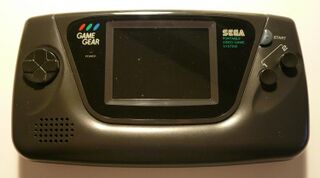
| |||||||||||||||||||||||||||||||||||||||||||||||||||||||||||||||||||||||||||||||||||||
| Sega Game Gear | |||||||||||||||||||||||||||||||||||||||||||||||||||||||||||||||||||||||||||||||||||||
|---|---|---|---|---|---|---|---|---|---|---|---|---|---|---|---|---|---|---|---|---|---|---|---|---|---|---|---|---|---|---|---|---|---|---|---|---|---|---|---|---|---|---|---|---|---|---|---|---|---|---|---|---|---|---|---|---|---|---|---|---|---|---|---|---|---|---|---|---|---|---|---|---|---|---|---|---|---|---|---|---|---|---|---|---|---|
| Manufacturer: Sega | |||||||||||||||||||||||||||||||||||||||||||||||||||||||||||||||||||||||||||||||||||||
|
The Game Gear (ゲームギア) is a handheld video game console developed by Sega and released in late 1990 as a response to Nintendo's Game Boy handheld . It is a full colour console and was Sega's first attempt to compete in the handheld games market (the second being the Sega Nomad — a handheld Mega Drive). In South Korea it is known as the Handy Gam*Boy (핸디겜보이) and Handy Aladdin Boy (핸디알라딘보이).
After development of the Sega Saturn began, the Game Gear was retroactively given the codename Mercury[9].
Contents
Hardware
The Game Gear is a "portable" device which was designed to address problems with Nintendo's Game Boy. It is held lengthwise at the sides (preventing the cramping of hands which plagued Nintendo's system) and has a backlit, colour LCD screen, allowing for clearer and more vibrant visuals than its main rival.
Similarly to the Mega Drive, which at the time was Sega's main focus in the home console market, the Game Gear is derived from the earlier Sega Master System. Unlike the Mega Drive, however, the Game Gear is largely identical to the Master System, the major difference being a VDP capable of displaying palettes consisting of a wider variety of colors, and the playback of stereo sound. Game Gear games traditionally run at a smaller resolution too, although with a screen built similarly to televisions of the era, the Game Gear is fully capable of playing games in higher resolutions.
Like the Master System, the Game Gear features a D-Pad and two buttons, ![]() and
and ![]() , but also adds a third, START . This is one button short of a Game Boy.
, but also adds a third, START . This is one button short of a Game Boy.
Unfortunately, due to technical limitations of the era, the Game Gear demands six AA batteries to be played on the go, of which the fluorescent backlight on the LCD screen will eat through in three to five hours (though a battery pack provides longer playtime). Furthermore, the system gives off more heat than the Game Boy, often leading to "sweaty palms" after prolonged use. The system was also considered not to be very "portable" - its bulky size means it does not fit in many pockets, and the power-draining backlight of the LCD screen (which cannot be turned off) meant Game Gears were unusable after a short period of time. An AC adaptor can be plugged into the system so that it runs off the mains, but this was not considered practical for consumers of the day.
Game Gears were also manufactured at a time where capacitor problems were rampant across the electronics industry. As a result, screen and audio failures are common, and fixes are not always simple.
Models
- Main article: Game Gear consoles.
Japanese model (Coca Cola Kid edition (Model #3210CR))
Japanese model (Magic Knight Rayearth edition (Model #HGG-3210 RAY))
Kid's Gear[10][11] (キッズギア) Japanese model (Virtua Fighter Mini edition)
Technical specifications
- See Sega Master System specifications for further specifications
The hardware is largely identical to the Sega Master System, with some of the differences mentioned below.
- CPU: Zilog Z80 (8-bit)
- Speed: 3.579545 MHz (same as NTSC colorburst)
- Resolution: 160 x 144 pixels
- Color palette available: 4096 colors
- Colors on screen: 32
- Sprites on screen: 64
- Sprite size: 8x8
History
- Main article: History of the Sega Game Gear.
Localised names
| Language | Localised Name | English Translation |
|---|---|---|
| English | Game Gear | Game Gear |
| Japanese | ゲームギア | Game Gear |
| Korean | 핸디겜보이 | Handy Gam*Boy |
| Hebrew | גיימגיר |
Games
- Main article: Sega Game Gear games.
Production credits
Magazine articles
- Main article: Sega Game Gear/Magazine articles.
Promotional material
- Main article: Sega Game Gear/Promotional material.
Logos by regions
| Logo | Region |
|---|---|
| International logo | |
| Used in Japan, Asia and Africa | |
| Used in North America, Asia and parts of South America | |
| Used in Brazil, Argentina, Paraguay and Uruguay | |
| Used in Western and Eastern Europe, Asia, Africa and Australasia | |
| Used in Arabian Peninsula | |
| Used in Scandinavia | |
| Used in South Korea |
Artwork
External links
- Sega of Japan catalogue pages (Japanese): Game Gear
- Console Database - Sega Game Gear info and FAQs
- SMS Power - Technical information and more on the Game Gear and its bigger brother, the Master System
References
- ↑ https://sega.jp/history/hard/gamegear/ (Wayback Machine: 2020-11-08 22:55)
- ↑ GamePro, "May 1991" (US; 1991-xx-xx), page 8
- ↑ 3.0 3.1 GamePro, "May 1991" (US; 1991-xx-xx), page 16
- ↑ 4.0 4.1 File:DailyMirror_UK_1991-06-29_08.png
- ↑ Mean Machines, "June 1991" (UK; 1991-05-29), page 11
- ↑ Raze, "September 1991" (UK; 1991-07-25), page 17
- ↑ Ação Games, "Julho 1991" (BR; 1991-07-xx), page 14
- ↑ 8.0 8.1 Alaab Alcomputtar, "" (SA; 1995-06-xx), page 12
- ↑ https://www.youtube.com/watch?v=wqdN_L4YaDE
- ↑ http://www.sega.co.jp/sega/athome/toys/k.html (Wayback Machine: 1997-02-15 22:20)
- ↑ http://www.sega.co.jp/sega_e/athome/toys/k.html (Wayback Machine: 1997-02-16 13:59)
- ↑ https://www.4gamer.net/games/999/G999905/20210126043/ (Wayback Machine: 2021-02-05 15:00)
- ↑ https://www.facebook.com/hiroyuki.ohtaka/about_work_and_education
| Sega Home Video Game Systems | ||||||||||||||||||||||||||||
| 83 | 84 | 85 | 86 | 87 | 88 | 89 | 90 | 91 | 92 | 93 | 94 | 95 | 96 | 97 | 98 | 99 | 00 | 01 | 02 | 03 | 04 | 05 | 06 | 07 | 08 | 09 | 10 | 11 |
|---|---|---|---|---|---|---|---|---|---|---|---|---|---|---|---|---|---|---|---|---|---|---|---|---|---|---|---|---|
| SG-1000 | SG-1000 II | Mega Drive | Mega Drive II | |||||||||||||||||||||||||
| SC-3000 | Mega-CD | Mega-CD II | Genesis 3 | |||||||||||||||||||||||||
| Sega Mark III | 32X | Dreamcast | ||||||||||||||||||||||||||
| Master System | Master System II | |||||||||||||||||||||||||||
| AI Computer | Game Gear | |||||||||||||||||||||||||||
| Saturn | ||||||||||||||||||||||||||||
| Pico | Beena | |||||||||||||||||||||||||||
| Sega Game Gear | |
| Topics | Sega Game Gear | History | Magazine articles | Promotional material | Merchandise |
|---|---|
| Hardware | Japan | North America | Western Europe | Eastern Europe | Asia | South America | Australasia | Africa Wide Gear |
| Add-ons | Pro Action Replay | Game Genie | X-Terminator | Master Gear Converter (Gear Master | Nuby Converter) | Stereo FM Tuner | TV Tuner |
| Cases | Carry-All | Deluxe Carry-All Case | Gear Bag | Holster Case | Standard Carrying Case | Soft Case | Third Party (Play & Carry Case) |
| Accessories | A/V Cable | Battery Pack | Car Adaptor | Car Antenna | Cleaning Gear | Gear-to-Gear Cable | PowerBack (Third Party) | Screen Magnifier (Wide Gear | Super Wide Gear | Third-Party) |
- JP Game Gear hardware
- US Game Gear hardware
- DE Game Gear hardware
- ES Game Gear hardware
- FR Game Gear hardware
- PT Game Gear hardware
- UK Game Gear hardware
- SE Game Gear hardware
- IT Game Gear hardware
- CZ Game Gear hardware
- AU Game Gear hardware
- MX Game Gear hardware
- BR Game Gear hardware
- KR Game Gear hardware
- SA Game Gear hardware
- Game Gear hardware
- Credits without reference
- Sega Game Gear
